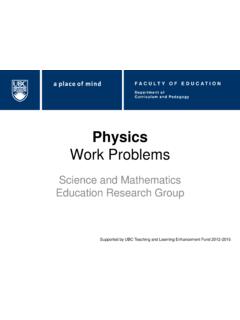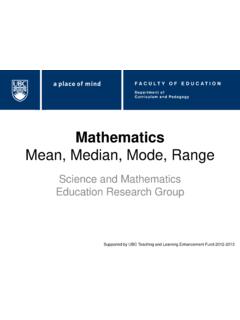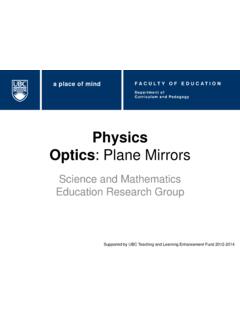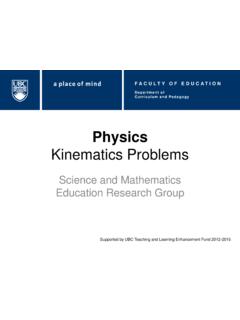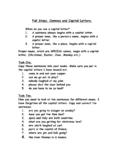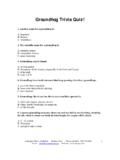Transcription of Circular Motion Problems
1 Physics Circular Motion Problems Science and Mathematics Education Research Group Supported by UBC Teaching and Learning Enhancement Fund 2012-2015 F A C U L T Y O F E D U C A T I O N F A C U L T Y O F E D U C A T I O N D e p a r t m e n t o f C u r r i c u l u m a n d P e d a g o g y F A C U L T Y O F E D U C A T I O N Question Title Question Title Circular Motion Problems Retrieved from: Question Title Question Title Circular Motion Problems The following questions have been compiled from a collection of questions submitted on PeerWise ( ) by teacher candidates as part of the EDCP 357 physics methods courses at UBC. Question Title Question Title Circular Motion Problems I A Ferrari is traveling in a uniform Circular Motion around a racetrack.
2 What happens to the radial acceleration of the car if the velocity is doubled and the radius of the circle is halved? remains the same. increases by a factor of 2. increases by a factor of 4. increases by a factor of 8. decreases by a factor of 2. Question Title Question Title Solution Answer: D Justification: The radial acceleration for a car in a uniform Circular Motion is: v is the velocity of the car and r is the radius of the Circular track v r Question Title Question Title Solution continued Note: If you are driving and you approach a curve, it is important to slow down because your acceleration increases by a factor of velocity squared. The sharper the curve is (the smaller the radius of Circular Motion ), the more acceleration you will need to be able to turn.
3 This acceleration is caused by the force of friction between the tires and the road. The friction force keeps the car going along the curved road. Thus, when it is raining (and the force of friction is decreased), remember to slow down while turning. If we double the velocity, we can see that the radial acceleration, ar will be increased by a factor of 4 (velocity is squared). If we halve the radius ( multiply it by ), then since it is inversely proportional to ar, the radial acceleration will increase by a factor of 2 (it will double). Therefore, ar is increased by a factor of 2 x 4 = 8 (answer D). Question Title Question Title Circular Motion Problems II Sonic is rolling towards a spring in order to quickly change the direction of his speed and make it around the loop.
4 The mass of the giant blue hedgehog is 30 kg and he is rolling towards the spring at 20 m/s. The spring is massless (and therefore perfect), can compress m and is attached to an immovable block. Question Title Question Title Circular Motion Problems II continued You can assume that there is no friction between the ground and rolling Sonic. What is the smallest the spring constant could be in order for Sonic to roll around the 30 m loop? already has enough kinetic energy to complete the loop therefore the value of the spring constant is irrelevant. value of the minimum spring constant is 71 kN/m. value of the minimum spring constant is 88 kN/m. value of the minimum spring constant is 119 kN/m.
5 Cannot make the loop regardless of the spring constant. Remember: Treat Sonic like an indestructible point mass sliding along his trajectory. Acceleration due to gravity = m/s2. Question Title Question Title Solution Answer: C Justification: This question is solved through the conservation and transfer of energy. How should you know this? The first hint is that we don't have mathematical tools as grade 12's to solve this problem any other way. The second hint is that time is not directly referenced in the problem. The third hint is that Sonic's velocity is the only factor that will determine whether he successfully makes the loop, and since his mass isn't changing, the velocity is only dependent on his kinetic energy.
6 The first thing that comes to mind when faced with this problem should be: "What conditions must be met in order for Sonic to make the loop?" Question Title Question Title Solution continued If we notice that the loop is a case of Circular Motion we can figure out the minimum velocity required to make the loop by using the formula for radial acceleration: The radius is half the diameter of 30 m. The minimum acceleration possible (and thus the minimum velocity possible) is the situation when the normal force provided by the loop, and acting on sonic, is zero. In that case the acceleration is only Sonic's acceleration due to gravity and thus we can find our velocity from the following formula: Question Title Question Title Solution continued 2 Now our task is to figure out how the spring constant impacts Sonic s ability to get to the top of the loop with a velocity of vmin = m/s Since Sonic has to change direction on impact with the spring all of Sonic s energy after impact has to come from the elastic potential energy stored in the spring.
7 Due to energy conservation we then know that the energy stored in the spring (ES) must be equal to the sum of Sonic's potential (EP) and kinetic (EK) energy at the top of the loop. Since we know the height of the loop and the minimum velocity required in order to maintain the Circular path we can calculate Sonic's energy at the top of the loop: Total Energy = Ek + EP = mvmin2 + mgh And since we know the spring can only compress m we can use the formula for elastic potential energy of a spring: ES = kx2 (where k is the spring constant and x is the amount of compression) Question Title Question Title Solution continued 3 L = m h = 30 m Possible stored energy: ES = kx2 In order to make the loop the spring must be able to store the energy required at the height of the loop Energy required to follow the Circular path.
8 Total Energy = Ek + EP = mvmin2 + mgh Question Title Question Title Solution continued 4 Now we can equate the two expressions together to solve for our spring constant: Question Title Question Title Solution continued 5 Notice that we did not need Sonic s initial velocity to solve this problem. Sonic loses a vast majority of his initial kinetic energy by slamming into the fully compressed spring before being launched in the opposite direction. Answer A is incorrect because it forgets that the direction of Sonic's Motion needs to be changed before his kinetic energy can be used to complete the loop. Answer B is incorrect because it fails to account for Sonic's kinetic energy at the top of the loop.
9 Answer D is incorrect because it uses Sonic s initial velocity to solve for the spring constant k. Answer E is incorrect due to the indestructible nature of Sonic and his surroundings. Even though Sonic completely compresses the spring and slams to a halt, the stored energy in the spring is still available to him and could propel him around the loop. Question Title Question Title Circular Motion Problems III You are at Playland enjoying the view from the Westcoast Wheel, their new $1 million Ferris wheel ride. Using Newton's second law determine where the magnitude of the force the seat exerts on you is: a) Smallest, so the rider feels the "lightest" b) Largest, so the rider feels the "heaviest ) At the bottom of the Ferris wheel b) At the top of the Ferris wheel ) At the top of the Ferris wheel b) At the bottom of the Ferris wheel centripetal acceleration is constant throughout the wheel so the riders feel their "true" weight at all the positions, never lighter or heavier.
10 Is not enough information given to solve this problem. Question Title Question Title Solution Answer: B Justification: This is a 2D kinematics problem involving Circular Motion . We can start solving the problem by looking at the two different positions of the rider, where position 1 is at the top of the ferris wheel and position 2 is at the bottom of the ferris wheel: 1 2 We know that in each location the force of gravity F = mg acts on the rider in the downwards direction. We also know that radial acceleration ar is always directed towards the center of the circle, and therefore the force due to radial acceleration (mar) for position 1 is directed downwards, while for position 2 it is directed upwards.

